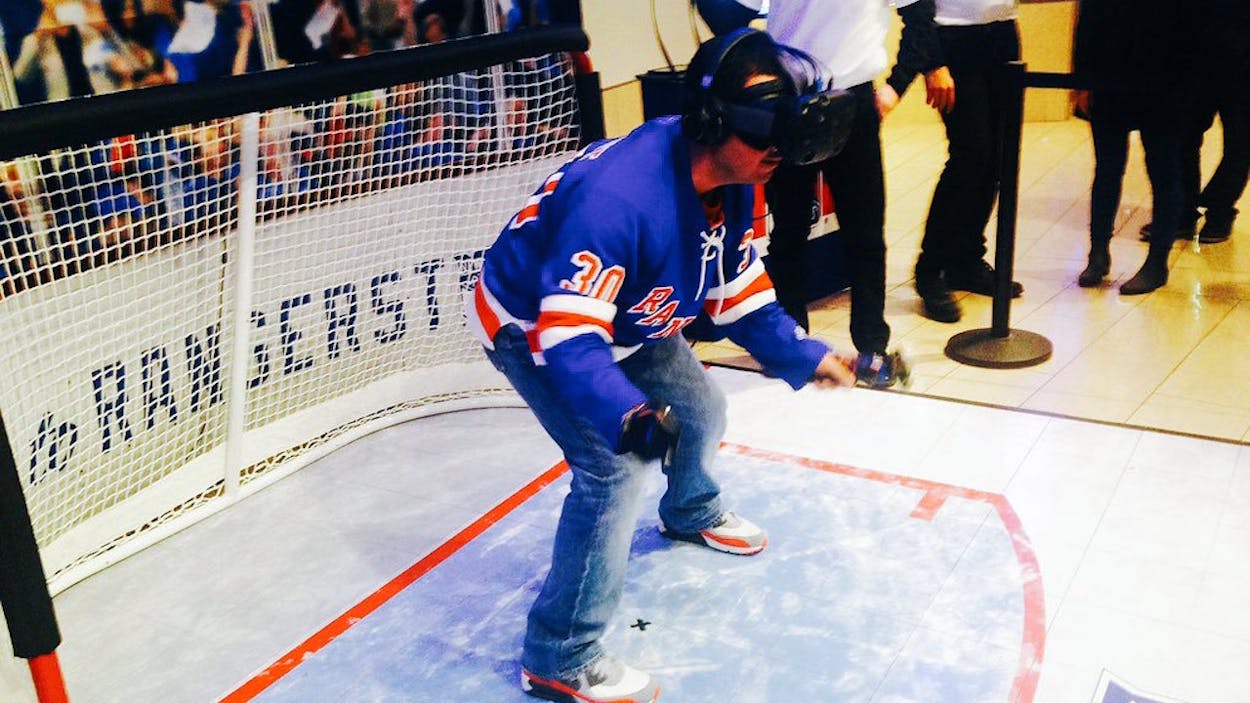When discussing the future of sports, things like “virtual reality training” have been the sort of big-picture ideas that people point to as a potential game changer. And the future arrived fifteen months ago: That’s when StriVR, a VR company formed by a handful of ex-jocks and a VR professor at Stanford, started signing up pro-sports franchises at a remarkable clip. Currently, the company has a whopping 28 franchises as clients among the NFL, NHL, NBA, MLB, Major League Soccer, and NCAA Division I Football. That’s impressive, especially considering that most pro-sports coaches aren’t the sort of people to say, “That training technique I’ve never heard of before, I definitely need that.” But StriVR made believers of organizations including the Dallas Cowboys, San Francisco 49ers, Arizona Cardinals, and Minnesota Vikings over the past year, and they took to SXSW to show off why.
The demo showcased both the practical opportunities afforded by their product and the fan-focused ones. According to the folks at StriVR, who set up camp at the Stephen F. Austin Intercontinental Hotel in downtown Austin for the first weekend of SXSports and SXSW Interactive, the three pillars of their business are training, fan experience, and recruiting. We’ll break down what each one looks like.
Training
StriVR’s marquee offering is actual player training, and the experience they showcased at SXSW was what they do for football teams. The organization has employees embedded with a number of the organizations it works with to create regular practice videos, essentially replacing the mind-numbing All-22 footage a football team watches during film study with engaging, immersive video. The difference here really is stark—not just the immersive nature of it, but also the detail you’re able to see. You can use the same footage to watch the quarterback’s footwork, or to look at the defensive keys, or to watch receiver patterns.
But the immersive element can’t be overstated, either. “Mental reps” are a real thing, but it’s very different to get them from a sideline, or from a desk in a film study room, than from a place that simulates the actual play being run in the first-person. The film study rooms that organizations use for this technology also allows them to simulate that environment (one team’s room for VR study has field turf on the ground, so players can move as though they’re actually on the field), and it’s easy to see the utility in letting, say, a quarterback who comes in after an injury see every practice snap that the starter took during the year.
There’s a dark side to this, too—or, at least, one that will probably require some additional regulation soon. VR training is considered film study, which means that it’s not regulated at the NCAA level by rules governing how often a player can practice. Coaches might love that, but it’s probably not great for student athletes who can find their workload increased an extra fifty hours of VR film study a week.
Fan Experience
One of the demos the StriVR team showed off was a practice experience they filmed with one of the more secretive teams in sports—the New England Patriots. With the headset on, you get an in-depth look at Gillette Stadium, lining up alongside Tom Brady to see the team take snaps. That’s novel, but of limited utility—it’s basically just a more detailed video.
The real potential here was in a program that StriVR created with hockey team the New York Rangers. Although they were loathe to call the experience a video game, that’s basically what it was—they filmed Rangers players on the ice coming toward the goal, and put the player in place as the goalie. Players had sticks in hand, and were tasked with blocking the shots. (The reason they wanted to avoid the term “video game,” they explained, was because the opposing player was real, it avoided an “uncanny valley” effect from unnatural movements that disrupts the player’s ability to see the encounter as real.) At the moment, it’s mostly just a more immersive, more natural version of a Nintendo Wii, but StriVR says that the naturalistic elements are what make it groundbreaking, and they’re only likely to get better.
Recruiting
Say you’re the Dallas Mavericks, and you want to lure Kevin Durant back to Texas to sign with you in the offseason. You’re not going to get a lot of time with the star, because nobody is going to get a lot of time with him—so when making your initial overture, you can include a VR look at the experience he’d have at practice in Dallas.
That’s a neat gimmick, even if it’s not necessarily how Durant is going to make his decision—but on the college level, it definitely has the potential to put smaller or more remote programs on the radar of high school recruits who may not have time for a visit. As a recruiting tool, VR is—at the very least—a neat development.








